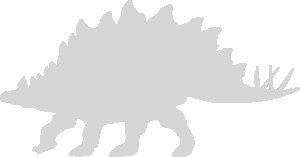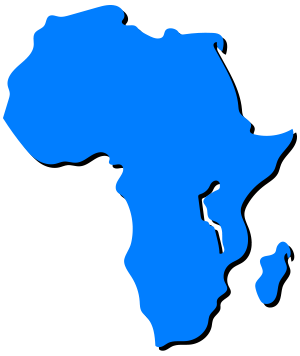Every month, 100,000 readers use the Dinosaur Database, but we receive no support from you. Developing and updating the database requires a lot of work. If you want it to remain open and be updated, please support us via the "Buy us a coffee" button available on every page or via the Support page.
Dinosaur: Thyreosaurus atlasicus

| Length*: | 7 m | 23.0 ft |
| Weight*: | 3.6 t | 7,937 lb |
*The largest known specimen
Period
Epoch: Middle Jurassic
Stage: Bathonian-Callovian
Years: 168.2–161.5 Ma
Details
Status: valid
Author: Zafaty et al.
Year: 2024
Distribution
Area: Africa
Country: Morocco
Region: Fès-Meknès
Formation: El Mers III
Description
Thyreosaurus atlasicus
Thyreosaurus atlasicus is a newly discovered stegosaurian dinosaur from the Middle Jurassic period, approximately 168 to 161 million years ago. It was discovered in the Boulahfa locality near Boulemane, in the Middle Atlas Mountains of Morocco. This dinosaur is notable for its unique dermal armor, which distinguishes it from other stegosaurs. The genus name, Thyreosaurus, derives from the Greek word “thyreos,” meaning a large oblong shield, referencing its armor, and “saurus,” meaning lizard. The species name, atlasicus, refers to the Atlas Mountains where the fossils were found. Thyreosaurus is significant as it provides new insights into the diversity and evolution of stegosaurs in North Africa during the Jurassic period.
Physical Characteristics
Thyreosaurus atlasicus was a medium to large-sized stegosaur, estimated to be around 6-7 meters (20-23 ft) in length. Its most distinctive feature is its dermal armor, which consists of thick, suboval to subrectangular osteoderms (bony plates) that could reach up to 4 cm (1.6 in) in thickness. These osteoderms are asymmetrical, with one side being roughly ornamented with small pits and fiber bundles, while the other side displays a well-marked cross-hatched pattern. This unique texture suggests that the osteoderms were arranged in a recumbent (lying flat) position over the body, rather than standing erect as in many other stegosaurs.
The dorsal vertebrae of Thyreosaurus are characterized by elongated neural arches and upturned transverse processes, typical of stegosaurs. The centra of the dorsal vertebrae are wider than long, a feature shared with other members of the Dacentrurinae subfamily. The neural spines are relatively low compared to other stegosaurs, and the ribs are straight, indicating a narrow ribcage. The limb bones are robust, with a possible fibula fragment suggesting strong, sturdy limbs.
Diet and Feeding Habits
As a herbivore, Thyreosaurus atlasicus likely fed on low-lying vegetation such as ferns, cycads, and other Jurassic plants. Its long neck would have allowed it to browse vegetation at various heights, while its small, spoon-shaped teeth were adapted for stripping leaves. Like other stegosaurs, Thyreosaurus likely swallowed its food whole, relying on gastroliths (stomach stones) to aid in digestion.
Habitat and Distribution
Thyreosaurus atlasicus lived in what is now North Africa during the Middle Jurassic. The fossils were found in the El Mers III Formation, which consists of gray marls and siltstones, indicating a continental environment with seasonal rainfall. The region would have been a mix of floodplains, river channels, and forests, providing a diverse ecosystem for herbivorous dinosaurs like Thyreosaurus. The presence of sauropod footprints and fossilized wood in the same formation suggests a rich and varied habitat.
Behavior and Social Structure
While direct evidence of social behavior in Thyreosaurus is lacking, it is possible that, like other stegosaurs, it lived in herds. Herding would have provided protection from predators and facilitated social interactions. The robust osteoderms of Thyreosaurus may have served a defensive purpose, deterring predators such as theropods that shared its environment.
Discovery and Research
Thyreosaurus atlasicus was first described in 2024 by a team of paleontologists led by Omar Zafaty. The holotype specimen, found in the Boulahfa North site, includes disarticulated dorsal vertebrae, ribs, a limb bone, and several osteoderms. The discovery of Thyreosaurus is significant as it represents the second stegosaur described from the Middle Jurassic of Morocco, following Adratiklit boulahfa. The unique dermal armor of Thyreosaurus has sparked interest in the evolution of stegosaurian osteoderms and their functional significance.
Significance and Interesting Facts
Thyreosaurus atlasicus is significant for several reasons. It provides new insights into the diversity of stegosaurs in North Africa during the Middle Jurassic, a period when stegosaurs were beginning to diversify globally. The unique arrangement and texture of its osteoderms suggest a different defensive strategy compared to other stegosaurs, which typically had erect plates or spines. The discovery of Thyreosaurus also highlights the importance of the Middle Atlas region as a rich source of Jurassic dinosaur fossils.
Locations
Sources
Material: Partial postcranial skeleton (9 dorsals, 21 dorsal rib fragments, limb bone (fibula?) and 6 dermal elements.
References: Zafaty, O.; Oukassou, M.; Riguetti, F.; Company, J.; Bendrioua, S.; Tabuce, R.; Charrière, A.; Pereda-Suberbiola, X. (2024). "A new stegosaurian dinosaur (Ornithischia: Thyreophora) with a remarkable dermal armour from the Middle Jurassic of North Africa".



